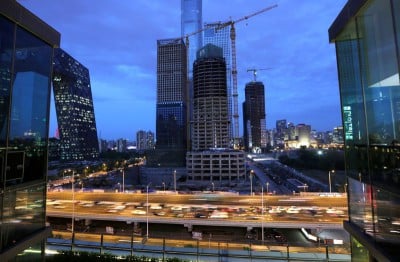Analysis-China
2/2  © Reuters. Vehicles drive through Beijing's central business area, China April 23, 2018. REUTERS/Jason Lee/File Photo 2/2 USD/CNY +0.06% Add to/Remove from Watchlist Add to Watchlist Add Position
© Reuters. Vehicles drive through Beijing's central business area, China April 23, 2018. REUTERS/Jason Lee/File Photo 2/2 USD/CNY +0.06% Add to/Remove from Watchlist Add to Watchlist Add Position
Position added successfully to:
By Kevin Yao BEIJING (Reuters) - China's central bank faces a major hurdle in quelling the threat of deflation: more credit is flowing to productive forces than into consumption, exposing structural flaws in the economy and reducing the effectiveness of its monetary policy tools. The People's Bank of China (PBOC) is under pressure to cut interest rates as falling prices raise real borrowing costs for private businesses and households, curbing investment, hiring and consumer spending. Deteriorating asset quality from the property crisis and local government debt woes is also pressuring central bankers to release liquidity into the banking system by cutting reserve requirements to fend off any risks of a funding crunch. But both moves share a common problem: demand for credit in China mainly comes from the manufacturing and the infrastructure sectors, whose overcapacity issues are exacerbating deflationary forces in the economy. Beijing has been redirecting money flows from its ailing property sector towards manufacturing in a bid to move its industries up the value chain. Infrastructure spending has been responsible for China's high investment rates for decades, diverting economic resources away from households. "Much of the credit is going to the infrastructure sector and also into some of the excess capacity," said Hong Hao, chief economist at Grow Investment Group. "That way, it actually creates further deflationary pressures. That's the problem." The PBOC "will continue to ease, but I think monetary policy at this juncture is less effective than it should be," he said. Analysts say the PBOC's predicament increases the urgency for the government to speed up structural reforms to boost consumption, a long-standing deficit in policies it has vowed to address throughout 2023, but struggled to make significant progress on. China's consumer prices fell by 0.5% year-on-year in November, the fastest in three years, while factory-gate prices tumbled by a whopping 3.0%, underscoring the weakness of both external and domestic demand relative to production capacity. December inflation data is due on Friday, while the PBOC could decide its next move on its benchmark rate on Jan. 22. A sustained period of falling prices may discourage further private sector investment and consumer spending, which in turn can hurt jobs and incomes and become a self-feeding mechanism that weighs on growth, as seen in Japan in the 1990s. FLOW WOES Weak private sector demand for credit shows up in China's money supply. The ratio between M1 money supply - which consists of cash in circulation and corporate demand deposits - and M2 money supply - which includes M1, fixed corporate, household and other deposits – fell to a record low in November. "Low M1 growth could be an indicator of weak private business confidence, or a byproduct of the property downturn, or both, suggesting less satisfactory policy transmission. This is really concerning," Citi analysts wrote. Of the 21.58 trillion yuan ($3.01 trillion) in new loans in January-November 2023, about 20% went to households, while corporate loans made up for the rest. Analysts said most of those loans were probably taken by state-owned enterprises, which typically have access to cheaper credit from state banks. Private companies, especially from sectors not deemed to be policy priorities, have a harder time. The PBOC's benchmark one-year loan prime rate (LPR) stands at 3.45%, the lowest since August 2019, after a series of rate cuts in recent years. When adjusted for factory-gate prices, however, the rate has in fact risen: at 6.45% in November, it is off a multi-year high of 8.95% in June, but still above China's expected GDP growth for 2023 of about 5%. STRUCTURAL IMBALANCES While analysts say structural imbalances require the PBOC to stick to incremental steps, rising real borrowing costs mean additional monetary easing is not without merit. Five of China's largest state banks lowered interest rates on some deposits on Dec. 22, which may pave the way for the PBOC to cut policy rates, potentially as early as this month. Citi expects a total of 20 basis points (bps) in policy rate cuts and a cumulative 50 bps reduction in the banks' reserve requirement ratios (RRR) this year. Goldman Sachs expects three RRR cuts of 25 bps each and one 10 bps policy rate cut. Tommy Xie, head of Greater China research at OCBC Bank, warned that more liquidity injections could increase deflationary pressures in the current mix of monetary, fiscal and other policies. "The focus of stimulus measures appears predominantly on the supply side," Xie said. "By bolstering production, these policies have played a crucial role in maintaining job stability. However, this increase in production has encountered a sluggish demand environment, heightening the risk of disinflation." In a speech in Hong Kong in November, central bank governor Pan Gongsheng promised to keep monetary policy "accommodative," but also urged reforms to make the economy less reliant on infrastructure and real estate. "What's needed to stave off the risk of greater disinflation is stronger demand and economic growth," said Frederic Neumann, chief Asia economist at HSBC. "To achieve this, it's best to make use of not just monetary easing, but implement supportive fiscal policy and structural reforms as well."
+ Add another position Close
($1 = 7.1743 Chinese yuan renminbi)
Analysis-China's policy dilemma: is boosting credit deflationary?
